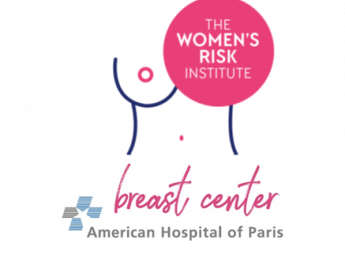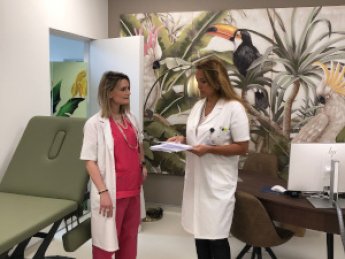Relieving post-mastectomy pain with cryoneurolysis
Cryoneurolysis: a new, minimally invasive therapeutic option to relieve post-mastectomy pain syndrome
Following a mastectomy – the surgical removal of a breast – many patients suffer from severe neuropathic pain in the breast area. Known as post-mastectomy pain syndrome, or PMPS, this frequent complication significantly impacts patients’ quality of life.
Because the pain is difficult to relieve with drugs, a new approach called cryoneurolysis is currently being developed. This minimally invasive therapy relieves the pain by freezing the nerve that is causing it. The procedure only lasts a few minutes.
What is post-mastectomy pain syndrome?
Post-mastectomy pain syndrome (PMPS) is a frequent complication of breast surgery. It affects an estimated 30 to 80 percent of women who have undergone a mastectomy (1), which is an operation to remove the entire breast.
Patients report experiencing severe nerve pain in the chest cavity, arm and armpit. The pain typically gets worse with physical activity and can manifest as “stabbing” or constant burning pain.
PMPS may be a result of:
- Damage to the nerves in the breast area
- The growth of painful scar tissue surrounding the nerves.
The pain may be caused by preoperative or postoperative factors:
- Preoperative factors: young age, obesity, depression, anxiety, preexisting pain, opioid use
- Postoperative factors: immediate postoperative pain, neuropathic pain, extreme sensitivity around the scar (hyperalgesia), chemotherapy, radiation therapy
Cryoneurolysis: an alternative to medication for relief of post-mastectomy pain
Post-mastectomy pain syndrome is difficult to treat. Therapy usually consists in prescribing medications like pain relievers and corticosteroids. Lymphatic drainage massage or botulinum toxin injections may also help.
Despite these different treatment options, some patients report that their pain levels remain constant and unrelieved over time, with a considerable impact on their quality of life.
New methods are therefore being developed to soothe post-mastectomy pain. Percutaneous cryoneurolysis is one such method that has already shown its efficacy in the treatment of neuropathic pain in various clinical contexts, including intercostal pain, herpes, shingles and spinal pain.
Post-mastectomy pain is often attributed to the intercostobrachial nerve, whose location makes it especially vulnerable during breast surgery. Cryoneurolysis of this nerve could therefore relieve the pain associated with PMPS.
What are the outcomes of cryoneurolysis for post-mastectomy pain?
A clinical trial conducted in 2022 tried to answer this question by focusing on 14 patients with PMPS. The aim was to evaluate the feasibility, safety and efficacy of intercostobrachial nerve cryoneurolysis to manage post-mastectomy pain in these patients (2).
The procedure was a success for all 14 patients:
- Significant decrease in mean pain at 10, 90 and 180 days after cryoneurolysis:
- Decrease of 2.1 points at 10 days (P = 0.0451)
- Decrease of 2.4 points at 90 days (P = 0.0084)
- Decrease of 2.9 points at 180 days (P = 0.0028)
- Significant decrease in the pain’s interference with daily activities:
- Decrease of 14.4 points after 10 days (P = 0.0161)
- Decrease of 16.2 points after 90 days (P = 0.0071)
- Decrease of 20.7 points after 180 days (P = 0.0007)
The study concludes that intercostobrachial nerve cryoneurolysis is technically feasible and safe. It leads to a significant drop in post-mastectomy pain and a clear improvement of quality of life.
Are there any risks involved with cryoneurolysis for post-mastectomy pain?
Cryoneurolysis to treat post-mastectomy pain is a minimally invasive interventional radiology procedure performed under local anesthesia.
It is performed by an experienced interventional radiologist under continuous X-ray guidance, which drastically lowers the risks of this type of procedure.
In addition, the above-mentioned trial reported no complications or adverse events linked to the procedure. Additional studies are necessary to expand enrollment beyond the initial 14 participants. Nevertheless, the authors already believe that cryoneurolysis could be an alternative to pain relieving drugs to treat post-mastectomy pain.
What happens during a cryoneurolysis procedure for post-mastectomy pain?
The cryoneurolysis procedure is performed under local anesthesia in an interventional radiology room.
Under CT-guidance, the doctor inserts a frozen needle under the patient’s skin, then positions the needle on the damaged nerve where extreme cold is delivered over the course of several freeze/thaw cycles. This exposure to extreme cold ablates the nerve, preventing it from sending pain signals. The nerve regenerates within 6 to 8 months.
The procedure only takes around 20 minutes, and has the advantage of being completely pain-free and scar-free. It is performed on an outpatient basis (no overnight hospital stay) and requires no postoperative care.
Make an appointment with our interventional radiologists
Learn moreSources & crédits


